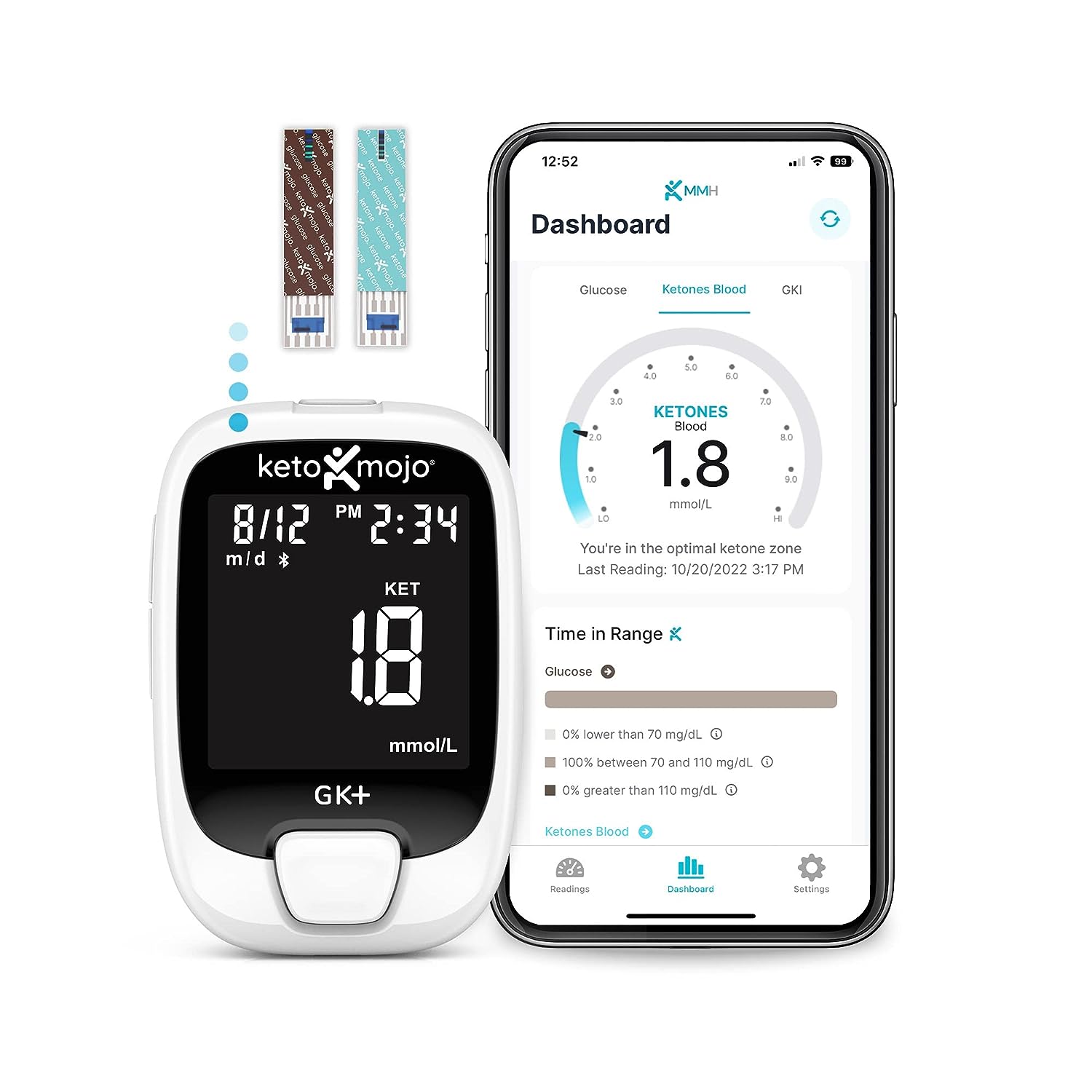Table of Contents
Precision Ketone Testing Meter: How to Interpret the Results
The Precision ketone testing meter is a valuable tool for monitoring ketone levels in your body. This quick summary will give you a brief overview of the step-by-step guide on how to interpret and understand the results from your meter.
In this guide, you will learn how to properly use the Precision ketone testing meter to obtain accurate results. You will also discover what the different readings mean and how they relate to your body’s ketone levels.
By following the step-by-step instructions in this guide, you will gain a better understanding of your ketone levels and how they may impact your health and wellness. This knowledge will enable you to make informed decisions about your diet and lifestyle.
Overall, the step-by-step guide on interpreting and understanding the results from your Precision ketone testing meter will empower you to take control of your health and optimize your ketogenic journey.
Step 1: Gather necessary materials
Before you start testing your ketone levels, it is important to have all the necessary materials within reach. This will ensure a smooth and efficient testing process. Make sure you have your Precision ketone testing meter, test strips, lancet device, and alcohol wipes ready. These are the essential tools you will need to accurately measure your ketone levels.
First, ensure that you have your Precision ketone testing meter. This device will be used to read and display your ketone levels. Make sure it is fully charged or has fresh batteries before starting.
Next, you will need test strips. These strips are specifically designed to measure ketone levels. Check the expiration date on the packaging to ensure accuracy. Open a new vial of test strips and make sure you have enough for the number of tests you plan to perform.
Now, prepare your lancet device. This device is used to prick your finger and collect a small blood sample for testing. Insert a fresh lancet into the device and adjust the depth according to your comfort level. Remember to dispose of used lancets properly.
Lastly, have alcohol wipes on hand. These wipes are used to clean your finger before pricking it. This helps to ensure a sterile environment and prevents contamination of the blood sample.
By gathering all these materials before starting, you will be fully prepared to accurately measure your ketone levels. This will help you monitor your progress and make any necessary adjustments to your diet or lifestyle.
Step 2: Prepare for testing
To ensure accurate results and prevent contamination, it is crucial to wash your hands thoroughly with soap and warm water before proceeding with the testing process. Follow these simple steps to effectively clean your hands:
- Wet your hands with warm water.
- Apply soap to your hands, ensuring you cover all surfaces.
- Rub your hands together for at least 20 seconds, making sure to lather the soap well.
- Pay special attention to the areas between your fingers, the back of your hands, and under your nails.
- Rinse your hands thoroughly under running water to remove all soap.
- Dry your hands well using a clean towel or air dryer.
Remember, washing your hands is essential as it helps remove any dirt, germs, or chemicals that may be present on your hands. By following these steps, you are taking an important measure to ensure the accuracy of your test results and maintain a contamination-free environment.
For example, imagine you have been gardening before testing your sample. By not washing your hands, any soil particles or bacteria present on your hands could potentially contaminate the testing equipment and compromise the accuracy of your results. So, make sure to prioritize hand hygiene before moving forward with the testing process.
Step 3: Insert a test strip
To insert a test strip into your meter, begin by taking a test strip from its container. Make sure your hands are clean and dry before handling the strip to avoid any contamination. Look for the instructions provided by the manufacturer, as the specific steps may vary depending on the type of meter you have.
Next, locate the slot or port on your meter where the test strip needs to be inserted. It is usually marked with an arrow or a symbol indicating the correct orientation. Carefully insert the test strip into the slot, making sure it is fully inserted and secure. Avoid bending or forcing the strip, as it may damage the meter or affect the accuracy of the results.
Once the test strip is correctly inserted, wait for the meter to prompt you to apply the blood sample. The meter will display a message or a symbol indicating that it is ready to receive the blood. Make sure you have a lancet device and a clean lancet ready to obtain a small drop of blood.
Remember, it’s important to always follow the instructions provided by the manufacturer of your specific meter to ensure accurate results. By following these simple steps, you will be able to insert a test strip correctly and proceed with measuring your blood glucose levels effectively.
Step 4: Prepare the lancet device
To load a lancet into your lancet device, follow these steps:
- Remove the cap or protective cover from the lancet device.
- Take a lancet and gently insert it into the lancet holder until it clicks into place.
- Make sure the lancet is securely loaded and not loose.
- Once the lancet is loaded, carefully remove any protective covering from the lancet tip, if present.
- Next, adjust the depth setting on your lancet device. This setting determines how deep the lancet will penetrate your skin and how much blood will be drawn for testing.
- Gradually turn the depth adjustment dial or slider to set the desired level. Start with a lower depth setting and increase if needed, based on your comfort level and the requirements of your blood test.
- Some lancet devices have different depth settings for different areas of the body, such as the fingertip or forearm. Make sure to adjust the setting accordingly.
Remember, it’s important to find a depth setting that is comfortable for you, as well as sufficient for obtaining an adequate blood sample for testing.
Step 5: Obtain a blood sample
To obtain a blood sample, start by selecting a fingertip and cleaning it thoroughly with an alcohol wipe. Ensure that the fingertip is dry before proceeding. For example, you can use the alcohol wipe to gently rub the selected fingertip in a circular motion for about 10 seconds.
Next, take the lancet device and position it against the side of your fingertip. Press the button or trigger on the device to prick your finger. Remember to hold the device firmly against your finger to ensure a sufficient blood flow. Once you have successfully obtained a blood drop, be careful not to touch the punctured area.
Now, it’s time to apply the blood sample to the designated area on the test strip. The test strip should have a specific area or indicator where the blood needs to be placed. Gently touch the drop of blood to this designated area, making sure to avoid touching the surrounding parts of the test strip.
Remember, accuracy is key when obtaining a blood sample, so make sure to follow these steps carefully. By selecting a clean fingertip, using the lancet device correctly, and applying the blood sample accurately to the test strip, you will ensure reliable test results.
Step 6: Read and interpret the results
- After you have successfully applied the blood sample to the ketone meter, patiently wait for a few seconds for the meter to analyze the sample.
- Once the analysis is complete, the ketone level will be displayed on the screen of the meter. Take note of this value as it indicates the concentration of ketones in your body.
- To understand what the result means in terms of ketone levels, refer to the user manual or the provided reference chart. These resources will help you interpret the result and give you an idea of whether your ketone levels are within a healthy range.
- Compare the displayed ketone level with the reference range mentioned in the manual or chart. This will give you an indication of whether you have elevated ketone levels, which may be a sign of ketosis or other conditions.
- Remember to consult with a healthcare professional if you have any concerns or questions about your ketone levels or their interpretation.
By following these steps and referring to the provided resources, you will be able to effectively read and interpret the results of your ketone meter.
Unveiling the Final Insights
In conclusion, you now have the knowledge and tools to confidently interpret and understand the results from your Precision ketone testing meter. Regular monitoring of ketone levels is crucial for those on a ketogenic diet or managing specific medical conditions. Don’t hesitate to reach out to your healthcare professional if you ever have any concerns or questions. Keep up the great work in taking charge of your health and stay on track with your goals.


I appreciate the step-by-step guide provided in this article. It makes the process of understanding and interpreting the results much easier. Well-written!
This article provides a clear and concise explanation of how to interpret the results from a precision ketone testing meter. Very helpful for those who are new to using such devices. Great job!
I found the tips and suggestions mentioned in this article extremely useful. It not only helps in interpreting the results accurately but also provides insights on how to improve ketone levels. Thank you!
The article does a great job of explaining the significance of precision ketone testing and why it is important. It’s a must-read for anyone using a ketone testing meter. Well done!